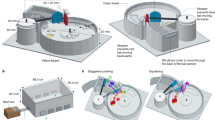Abstract
Insects used in research have traditionally been housed and cared for in the investigator's laboratory. Centralized colony maintenance may be advantageous, but presents unique challenges to animal care staff members, who are more familiar with vertebrate research animals. To fill this potential knowledge gap, the authors share the procedures they have developed at Arizona State University for the housing, husbandry, and breeding of grasshoppers used in research and teaching.
This is a preview of subscription content, access via your institution
Access options
Subscribe to this journal
We are sorry, but there is no personal subscription option available for your country.
Buy this article
- Purchase on Springer Link
- Instant access to full article PDF
Prices may be subject to local taxes which are calculated during checkout




Similar content being viewed by others
References
Smith, S.A. & Berkson, J. Laboratory culture and maintenance of the horseshoe crab (Limulus polyphemus). Lab Anim. (NY) 34(7), 27–34 (2005).
Quinlan, M.C., Tublitz, N.J. & O'Donnell, M.J. Anti-diuresis in the blood-feeding insect Rhodnius prolixus Stal: the peptide CAP2b and cyclic GMP inhibit Malpighian tubule fluid secretion. J. Exp. Biol. 200 (Pt 17), 2363–2367 (1997).
Buhl, J. et al. From disorder to order in marching locusts. Science 312(5778), 1402–1406 (2006).
Clark, A.B. A Practical Course in Experimental Zoology (Wiley, New York, 1966).
Hoyle, G. in Experiments in Physiology and Biochemistry (ed. Kerkut, G.A.) 287–293 (Academic Press, New York, 1968).
Miller, T.A. Insect Neurophysiological Techniques (Springer, New York, 1979).
Scott, J. The locust jump: an integrated laboratory investigation. Adv. Physiol. Edu. 29(1), 21–26 (2005).
Ma, Z., Yu, J. & Kang, L. LocustDB: a relational database for the transcriptome of the migratory locust (Locusta migratoria). BMC Genomics 7, 11–15 (2006).
Harrison, J.F. & Kennedy, M.J. In vivo studies of the acid-base physiology of grasshoppers: the effect of feeding state on acid-base and nitrogen excretion. Physiol. Zool. 67(1), 120–141 (1994).
Krolikowski, K. & Harrison, J.F. Haemolymph acid-base status, tracheal gas levels and the control of post-exercise ventilation rate in grasshoppers. J. Exp. Biol. 199 (Pt 2), 391–399 (1996).
Greenlee, K.J. & Harrison, J.F. Development of respiratory function in the American locust, Schistocerca americana. I. Across-instar effects. J. Exp. Biol. 207 (Pt 3), 497–508 (2004).
Rascon, B. & Harrison, J.F. Oxygen partial pressure effects on metabolic rate and behavior of tethered flying locusts. J. Insect Physiol. 51(11), 1193–1199 (2005).
Henry, J.E. in Handbook of Insect Rearing. Vol. I (eds. Singh, P. & Moore, R.F.) 451–464 (Elsevier Science, New York, 1985).
Gardiner, B.O.C in Handbook of Insect Rearing. Vol. I (eds. Singh, P. & Moore, R.F.) 465–468 (Elsevier Science, New York, 1985).
Uvarov, B. Grasshoppers and Locusts: A Handbook of General Acridology (Centre for Overseas Pest Research, London, 1977).
Henry, J.E. & Oma, E.A. Sulphonamide antibiotic control of Malameba locustae (King & Taylor) and its effect on grasshoppers. Extrait d'Acrida 4, 217–226 (1975).
Acknowledgements
The authors express their gratitude to Larry Neinaber, Jaime White-James, and Derek O'Neill of the Arizona State University Animal Care Program for their contributions to the development and implementation of this care and use program.
Author information
Authors and Affiliations
Corresponding author
Ethics declarations
Competing interests
The authors declare no competing financial interests.
Rights and permissions
About this article
Cite this article
Badman, J., Harrison, J. & McGarry, M. Grasshoppers in research and education: methods for maintenance and production. Lab Anim 36, 27–31 (2007). https://doi.org/10.1038/laban0307-27
Received:
Accepted:
Issue Date:
DOI: https://doi.org/10.1038/laban0307-27
This article is cited by
-
Intermolt development reduces oxygen delivery capacity and jumping performance in the American locust (Schistocerca americana)
Journal of Comparative Physiology B (2012)



